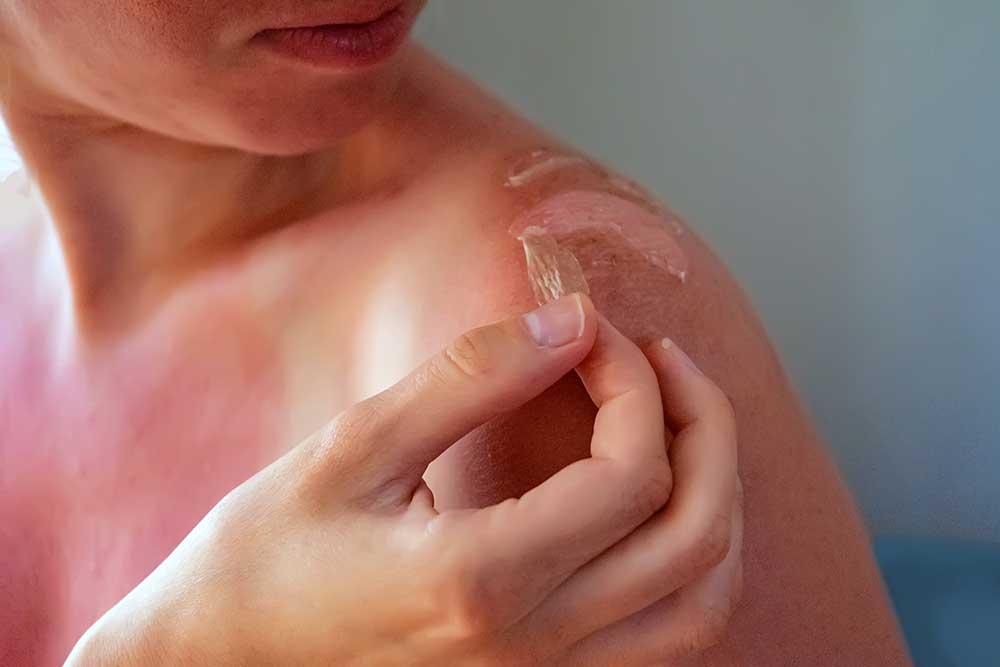When Does Sunburn Become Serious?

Who doesn’t like summer, with long lazy days and plenty of good, healthy outdoor activities? Those happy times in the sun can quickly turn to misery if you suffer from sunburn, however. Mild sunburn is quite common, and won’t generally cause any long-lasting or overly painful symptoms. Getting a tan is part of the pleasure of summer outdoors, and you can’t get a tan without mild sunburn.
It’s easy to let it go too far, though. Out in the sun, we often don’t feel discomfort that indicates sunburn. It’s only later that burning symptoms become apparent and by then, the damage is done. Knowing how to identify sunburn that’s going too far can help you prevent it, and clue you in about when it’s time to visit the emergency room.
How Tanning Happens
Melanin gives the skin color; the tones we’re all familiar with. Typically, dark-haired people have a naturally deeper skin tone, with blonds typically having paler skin.
Since melanin blocks some of the UV rays from the sun, exposure to sunlight encourages the skin to produce more. More melanin turns the skin darker, making it look tanned. Tanned skin is, to some extent, more protected from burning but that doesn’t mean you can go without protection once you have a tan.
Mild to Moderate Sunburn
If you have a mild to moderate sunburn, you may experience some of the following:
- Skin feels hot to the touch
- Rubbing causes pain
- Skin looks red and tender
- Feeling dehydrated
- Blisters may appear
- Skin can peel as it heals
You can treat many cases at home. Some of the treatments to try include:
- Over the counter pain medications like ibuprofen
- Aloe vera lotions or gels (applied gently)
- Drinking plenty of fluids (non-alcoholic)
- Antihistamines such as Benadryl
- Cool compresses or soaking in cool water (avoid soap as this can irritate a burn)
If the sunburn covers a large area of the body or you’re feeling pain or getting blisters over large areas, you should consult a medical professional.
Blistering is common following sunburn, and these can be painful. Most will break by themselves and if possible, you should let them, rather than pop them deliberately. Popping them can lead to infection that needs medical treatment. If blisters rub against clothes and cause pain, a loosely applied dressing can help but avoid tight dressings as these can also cause infections.
If you don’t see any improvement in the sunburn after a few days, it may be more serious than you thought and you should seek professional advice and treatment.
Types of treatment depend on the severity of the sunburn, but may include a course of prednisone or a corticosteroid cream.
Identifying Severe Sunburn
We’d take severe sunburn more seriously if we commonly called it sun poisoning. Symptoms are the same as those listed for milder sunburn above, but in addition the sufferer may experience any of these additional symptoms:
- Nausea
- Dizziness
- Rapid pulse and breathing
- Fever
- Chills
- Headaches or confusion
- Dehydration
- Loss of consciousness
- Severe blisters
- Skin feeling very sore and tender
Severe sunburn is also associated with heatstroke or heat exhaustion, both of which are medical emergencies.
Very severe cases of sunburn can be dangerous and need emergency medical treatment, which will vary depending on the severity and how extensive the burn is. In extreme cases, you may be admitted to the burns unit of the hospital.
Prevention is Better Than Cure
Being aware of how easy it is to overexpose your skin to the sun helps you avoid the extreme instances of sunburn. Where you are in the world along with your skin type is another factor to bear in mind. High altitudes and fair skins, for instance, call for more vigilance.
For general protection, follow these guidelines
- Avoid direct sunlight between 10am and 3pm. Between these hours the sun is at its highest, with increased risk of sunburn
- Wear a high factor sunscreen all the time, even on cloudy days. High factors are those of 15 or above. Many specialists recommend a factor of 30
- Apply sun protection every two hours, more if you go in water or sweat profusely
- Supply your own shade in the form of a wide-brimmed hat and long sleeves
- Drink plenty of water to keep yourself hydrated. Don’t overdo it though, because too much water can cause problems too. The best guide is to not get thirsty. If you feel thirsty, you’re already dehydrated
Always take care in the sun. A little exposure is pleasant and the Vitamin D value makes a difference to your health. A light tan often makes us feel better, too. Sunburn, though, is painful and can lead to much more serious conditions, especially later in life.




